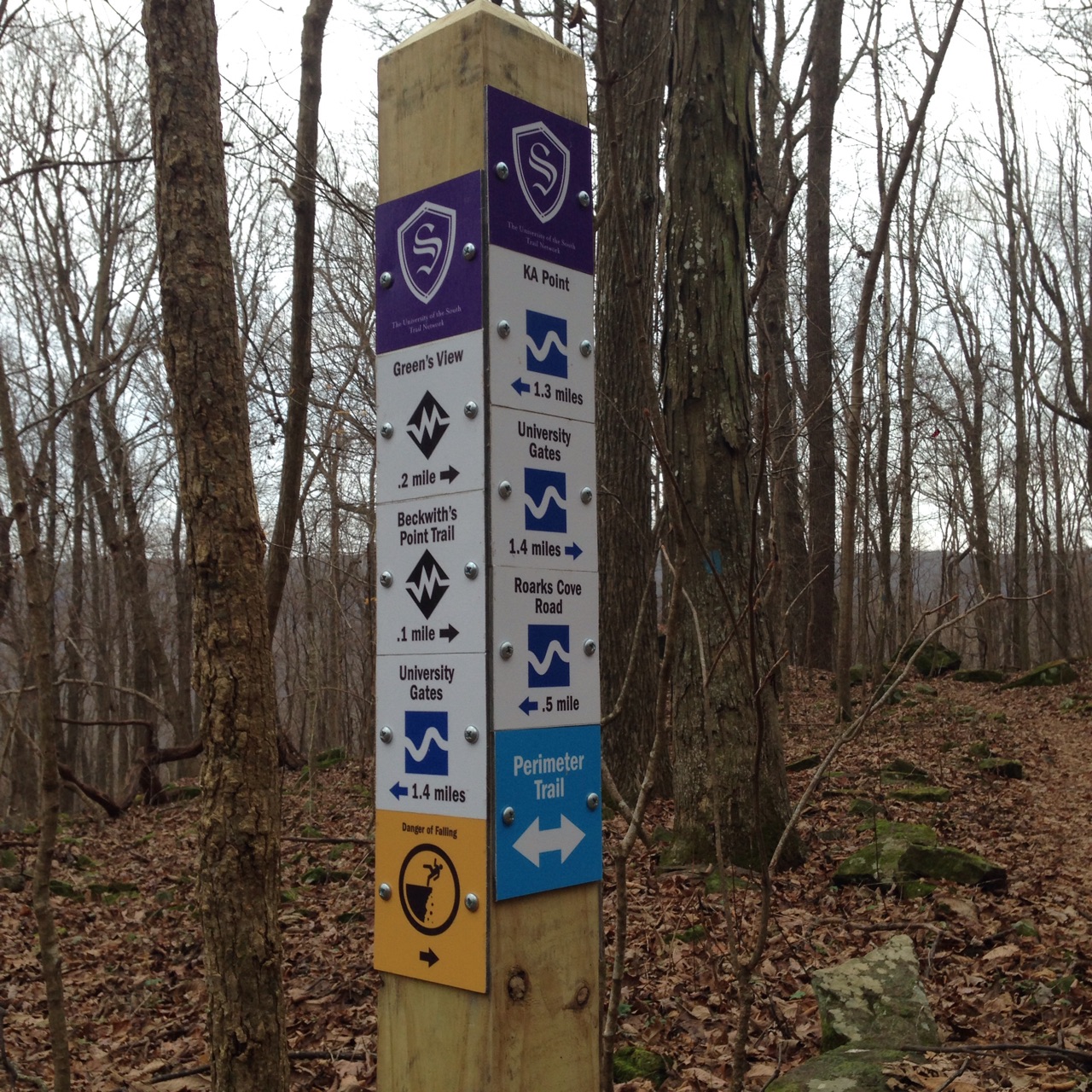Trail signs & the perception of wilderness
 At the end of Green’s View Road, with its northwest-facing vista across the farms and fields, you can take a right and follow the steep, rooty trail until it offers the choice of the Perimeter Trail proper, descending abruptly to the left, or the Beckwith Loop up and to the right.You’ll also see the new signs for the trail system. The new trail markers are small vertical posts, with several icons, some white, some yellow (the ones alerting users to danger), and the ones on top purple, bearing the ubiquitous Sewanee Gothic “S.”Inevitably, there will be people who think the signs are too garish, compared to the previous dark-brown wooden ones. I can imagine that some will feel that their outdoor experience has been lessened by the presence of such ‘unnatural’ shapes and colors on the Perimeter Trail.Where does this reaction come from? The Perimeter Trail sees regular users throughout the year -- hikers, runners, and mountain bikers. It passes within sight of homes and power lines. It crosses Roark’s Cove Road and Highway 41A. Wilderness it ain’t.It’s as though we need to fool ourselves, to be able to believe that we’re in a wilder place than we are. We want to pretend like kids hiding in a cardboard fort, or making a backyard thicket into the jungles of Africa. And manmade objects — especially newly-appeared ones — can get in the way of our creating that headspace.All of which makes me think that it’s all about perception, and the illusion of separateness, of wildness. Does a painted stick affect the physical relationship between a person and the woods? Why is a brown piece of wood okay, but a white and purple one not?Not far from the new signposts, the Beckwith trail skirts the edge of the Sewanee golf course. Is that more or less disruptive to one’s feeling of being in nature? Why?Climbers’ huts in the Alps are perched right on the dizzying edges of mountains, offering bunk beds, stoves, even meals. Some are old stone, some modernistic steel cubes. Does their presence make the Alps any less magnificent, the climbs less challenging?The outdoor-wear company Patagonia once published an article in their catalog defending bright colors of their clothing, quoting Flaubert in arguing that rainshells didn’t have to be mud-brown or olive-green. Why is the brilliance of sumacs in fall okay, but that of a red fleece layer not?Of course there are, and should be, locales where there are no signs of humans. Some parts of our national parks fit the bill, as do certain other wilderness areas, national monuments, and national forests. Everywhere else, though, the balancing of access and beauty, safety and enjoyment, has to be constantly worked on and lived with.I am told that there are university students, less experienced at being outside away from well-delineated paths, who are much more comfortable being on the Perimeter Trail with the new signs. To me, that makes them worth it.
At the end of Green’s View Road, with its northwest-facing vista across the farms and fields, you can take a right and follow the steep, rooty trail until it offers the choice of the Perimeter Trail proper, descending abruptly to the left, or the Beckwith Loop up and to the right.You’ll also see the new signs for the trail system. The new trail markers are small vertical posts, with several icons, some white, some yellow (the ones alerting users to danger), and the ones on top purple, bearing the ubiquitous Sewanee Gothic “S.”Inevitably, there will be people who think the signs are too garish, compared to the previous dark-brown wooden ones. I can imagine that some will feel that their outdoor experience has been lessened by the presence of such ‘unnatural’ shapes and colors on the Perimeter Trail.Where does this reaction come from? The Perimeter Trail sees regular users throughout the year -- hikers, runners, and mountain bikers. It passes within sight of homes and power lines. It crosses Roark’s Cove Road and Highway 41A. Wilderness it ain’t.It’s as though we need to fool ourselves, to be able to believe that we’re in a wilder place than we are. We want to pretend like kids hiding in a cardboard fort, or making a backyard thicket into the jungles of Africa. And manmade objects — especially newly-appeared ones — can get in the way of our creating that headspace.All of which makes me think that it’s all about perception, and the illusion of separateness, of wildness. Does a painted stick affect the physical relationship between a person and the woods? Why is a brown piece of wood okay, but a white and purple one not?Not far from the new signposts, the Beckwith trail skirts the edge of the Sewanee golf course. Is that more or less disruptive to one’s feeling of being in nature? Why?Climbers’ huts in the Alps are perched right on the dizzying edges of mountains, offering bunk beds, stoves, even meals. Some are old stone, some modernistic steel cubes. Does their presence make the Alps any less magnificent, the climbs less challenging?The outdoor-wear company Patagonia once published an article in their catalog defending bright colors of their clothing, quoting Flaubert in arguing that rainshells didn’t have to be mud-brown or olive-green. Why is the brilliance of sumacs in fall okay, but that of a red fleece layer not?Of course there are, and should be, locales where there are no signs of humans. Some parts of our national parks fit the bill, as do certain other wilderness areas, national monuments, and national forests. Everywhere else, though, the balancing of access and beauty, safety and enjoyment, has to be constantly worked on and lived with.I am told that there are university students, less experienced at being outside away from well-delineated paths, who are much more comfortable being on the Perimeter Trail with the new signs. To me, that makes them worth it.